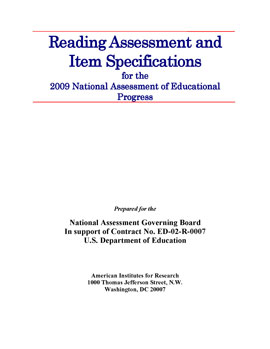
Reading Assessment and Item Specifications for the 2009 National Assessment of Educational Progress
This document is divided into nine chapters as briefly described below. A glossary of terms used in the Exhibits and throughout the 2009 NAEP Reading Specifications is provided in Appendix B.
Chapter 1: Introduction
This chapter contains information on NAEP administration and student samples and NAEP achievement levels. This chapter provides background on the NAEP Reading Assessment, including the history of the Framework, as well as a brief overview of the 2009 NAEP Reading Framework development process and a comparison of previous Frameworks to the 2009 Frameworks. This chapter also outlines the context of the No Child Left Behind legislation with regard to NAEP.
Chapter 2: Assessment Specifications
This chapter provides guidelines that apply to developing the assessment as a whole. It includes information about how the entire item pool should be structured so that it is aligned with the NAEP Reading Framework.
This chapter also provides an overview of text types on the assessment, presents guidelines for selecting passages, provides exhibits about the distribution of passages across grades and text types, and introduces the vocabulary assessment in terms of passage selection. Passage mapping is also discussed in this chapter and elaborated on in Appendix C.
Chapter 3: General Item Specifications by Text Type, Cognitive Target, and Grade Level
This chapter focuses on item specifications that apply to all the grade levels assessed. It includes full discussions of the characteristics of NAEP Reading Assessment items as well as descriptions of item formats and item-writing guidelines. It also introduces the literary and informational text matrices and provides a discussion of the cognitive target matrix, guided by exhibits.
Chapter 4: Inclusion of Students With Disabilities and English Language Learners
This chapter describes accommodations and other considerations for assessing students with disabilities and students who are English language learners. It includes item-writing considerations for these students which apply to all the items written for the assessment.
Chapter 5: Vocabulary Assessment on the 2009 NAEP Reading Assessment
This chapter introduces a systematic approach to vocabulary assessment on the 2009 NAEP Reading Assessment. It discusses the measurement of meaning vocabulary and includes criteria for selecting vocabulary to be assessed.
Chapter 6: Scoring the NAEP Reading Assessment
This chapter discusses item types and score categories and provides guidelines for the development of scoring rubrics. Alignment of items and scoring rubrics is also discussed.
Chapter 7: Reviews and Item Try-Outs
This chapter discusses the review and quality control procedures built into the assessment development process. It focuses on item reviews including sensitivity reviews, classroom tryouts, and cognitive labs.
Chapter 8: Sample Items
This chapter contains sample items illustrating the concepts and item-writing principles in Chapter 2 and the specifications for text types, cognitive targets, and grade levels described in Chapter 3.
Chapter 9: Special Studies
This chapter describes three recommended special studies that examine the assessment of vocabulary in context, achievement patterns of English language learners, and gender differences in reading achievement

2009 Reading Specification
2009 Reading Specification